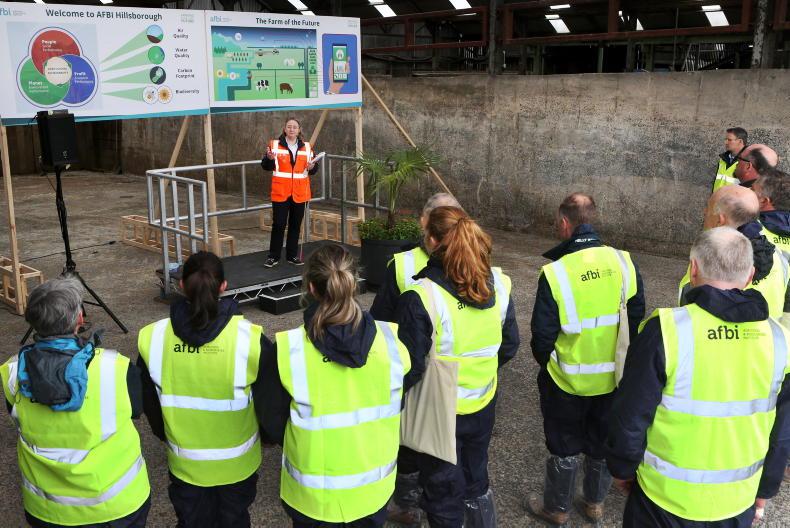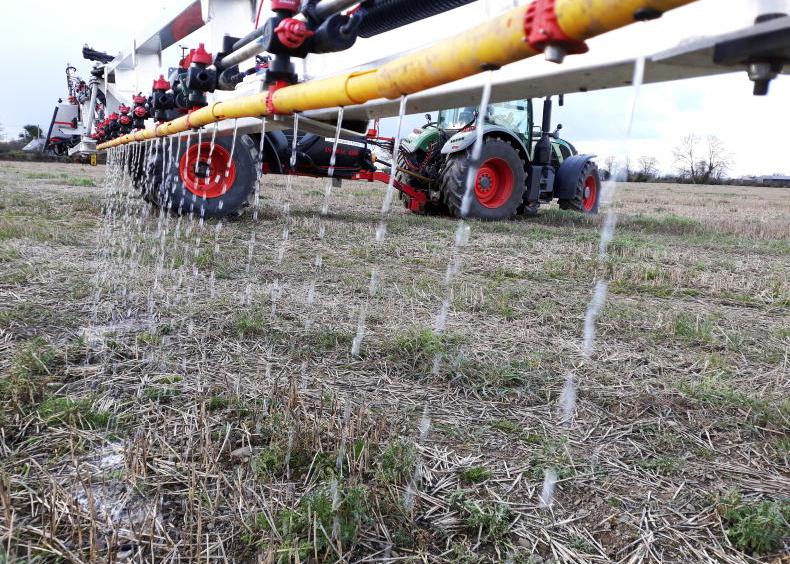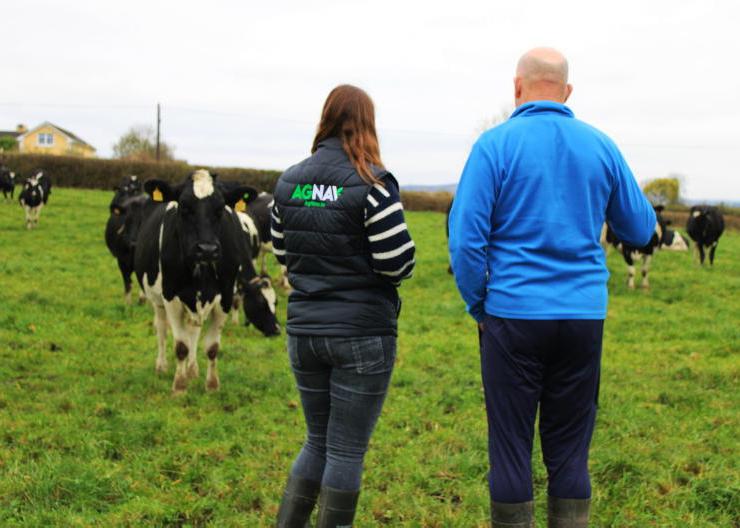A report commissioned by the Centre for Innovation and Excellence in Livestock (CIEL) into how farmers can reduce greenhouse gas (GHG) emissions, has identified some of the key mitigations that could be used, and the impact each might potentially have.
Involving scientists from across the UK, the lead authors in the report are Professor Elizabeth Magowan and Dr Steven Morrison from the Agri-food and Biosciences Institute (AFBI). As part of the work, the authors looked at emissions from the five main livestock sectors – dairy, beef, sheep, pigs and poultry.
With agriculture expected to contribute to an overall target for the UK to have net zero emissions by 2050, the study authors conclude that wide-scale adoption of some of the most important mitigations could initially result in a 23% reduction in GHGs from UK agriculture. “While this is encouraging, it also indicates much more innovation, adoption and the realisation of carbon capture is needed,” states the report.
In the dairy sector the study looks at two possible scenarios. The first is a spring-calving herd producing 5,267l per cow, with a stocking rate of 2.64 livestock units per hectare (LU/ha), fertiliser input of 242kg N/ha, and heifers calved at 24 months.
The main changes on the farm that drive down emissions include the earlier sale of surplus stock, using protected urea fertiliser, and also nitrification inhibitors when applying other nitrogen-based fertiliser (reducing nitrous oxide losses – a potent GHG).
Overall fertiliser use is reduced by including legumes such as clover. Both scenarios also model the impact of including a methane inhibitor in the cow diet.
As on any cattle and sheep farm, methane released during the rumination process is a key contributor to GHG emissions, accounting for 43% of the carbon footprint (total emissions) of this spring-calving farm.
With initial research around methane inhibitors promising, the report authors point out that these products should be available “in the near future”, but acknowledge that they are initially making an assumption as to their value on farm. In the spring-calving model, assuming a methane inhibitor is 15% effective, it reduces overall emissions from the farm by 7.1%. This increases to 14.3% if the inhibitor is 30% effective.
Including legumes in grassland (allowing less fertiliser to be spread) cuts emissions 8.4%, while using products such as protected urea reduces emissions by 2.8%. Selling surplus dairy stock earlier in the production cycle, along with improved grassland management, results in 7.6% less emissions.
Where surplus stock are sold, grassland management improved, and a methane inhibitor fed (30% effective), overall emissions can be brought down by 21.1%.
But if the land released by selling surplus stock earlier and better grassland management is used for forestry, these trees will take in carbon, and overall net farm emissions fall 31.6%.
High output
The second model is a high-output indoor system, with cows averaging 10,377l. The farm is stocked at 2.27LU/ha, with fertiliser at 159kg N/ha and heifers calved in at 25 months.
Reducing age at first calving to 24 months has little impact (1.4% reduction in emissions), while using the likes of protected urea cuts emissions 2.4%, and including legumes in grassland brings about a 4% reduction.
The biggest impact is the use of a methane inhibitor which, if 30% effective, reduces emissions 14.2%. Combined with reduced age at first calving, the overall carbon footprint of this farm falls 15.4%, and if released land (because stock are sold earlier) is planted in trees, it is a 16.7% reduction.
National
The CIEL report also goes on to look at the potential impact if a range of mitigations were taken up by all dairy farmers across the UK.
Feeding a methane inhibitor to all dairy cattle could cut emissions 20.3%, while increasing productivity via a 15% increase in yield per cow would mean 13% less cows and followers are kept (overall milk output stays the same), and reduce emissions by 8.7%.
Processing all dairy slurry though anaerobic digestion (AD) plants reduces emissions 12%, while protected urea and other inhibitors that reduce nitrous oxide loss when spreading fertiliser cut emissions 9.7%.
Taking the national average age at first calving from 29 months to 24 months equates to a 4% reduction.
Combined, all these mitigations equate to a highly theoretical 45% reduction in GHGs from the UK dairy industry, which would deliver a 12.5% reduction in emissions from UK agriculture as a whole.
Average beef units have scope to cut emissions
An average-performing suckler to beef farm could potentially cut GHG emissions by over one-third, the CIEL report shows.
To demonstrate the impact of various management changes, the report authors started with a 100-cow unit, with a calving rate of 86%, slaughtering 79 prime cattle per year at an average of 364kg at 21 months.
Cows averaged 700kg liveweight, and all heifers are calved in at three years.
The changes applied to the model include more calves being successfully reared per year, heifers calved in at two years, cow weight being cut 10%, and age at slaughter reduced to 18 months.
Grassland management is also improved, with nitrification inhibitors used to reduce nitrous oxide losses related to spreading fertiliser.
Methane
In the dairy model, the use of methane inhibitors when included in the diet could potentially reduce GHG emissions by up to 20%, but on a beef farm it is recognised that it is more difficult to feed a product when beef cattle are at grass.
In this beef model, the methane inhibitor is assumed to be 10% effective (compared to up to 30% effective in dairy).
When all the various mitigation factors were combined, the study showed that GHG emissions on this average farm could be cut by 37.2%.
The biggest impacts were when heifers were calved younger, cattle slaughtered earlier and grassland management improved.
Overall
A second model showed that if all beef cattle across the UK were fed a methane inhibitor (30% effective) and this was combined with an increase in productivity (same output but with 5% less suckler cows), the industry could cut its carbon footprint by a theoretical 23.2%.
Global average
There is a recognition in the CIEL report that UK beef production has GHG emissions intensity around half the global average, but the report authors point out that further improvements are required to contribute to the UK’s net zero goal.
The report does not compare emissions of dairy versus suckler-bred beef, although it does refer to “substantial reductions” in carbon footprint when the beef is produced from dairy cows.
‘Challenging’ to feed a methane inhibitor to sheep
Just like dairy and beef, in the sheep sector the major contributors to its carbon footprint are methane from ruminant digestion followed by nitrous oxide released when fertiliser and manures are spread. On average, lowland farms are more productive, so have less GHG emissions per kg than upland or hill farms.
The CIEL report considers three sheep models – an organic hill farm with Welsh ewes, a hill farm with Mule and Texel ewes, and a lowland farm with Lleyn and Abermax ewes.
When a range of management changes were applied on these farms including improved grassland management, use of legumes (such as clover), better flock health, and improved nutrition, the carbon footprint could be reduced by up to 38%. If methane inhibitors were fed, the reduction could be as high as 67%.
However, the report authors acknowledge that it would be “challenging” to feed a methane inhibitor to sheep, especially in hill areas.
If all lowland sheep in the UK were fed this inhibitor it could, in theory, reduce overall sheep GHG emissions by 10%.
Low emissions in pigs and poultry
In the intensive pig and poultry sectors, greenhouse gas emissions per unit of output are significantly lower than in dairy, beef and sheep systems.
The vast majority of emissions on an individual farm unit are related to the production and transport of feed.
However, most of this feed is imported into the UK, so the emissions associated with these crops are realised in the country where the crop is grown, and do not appear in UK national figures. As a result, emissions from UK production are mainly from how manure is managed and spread.
Despite that, the CIEL report authors note that it is important to consider the impact that the intensive sector has on global emissions. In particular, soya bean meal is the main source of protein in diets, but if coming from a country where land is being deforested to make way for the crop (land use change), it has a high carbon footprint.
“With regard to pigs and poultry, while their impact on national emissions is smaller than ruminants, their carbon footprint is greatly influenced by the source of feed ingredients,” notes the report authors.
However, they also argue that soya from ‘non land use change’ should “not be considered negatively”.
Read more
Farmers protecting the nation’s carbon
Managing our hills – ‘the secret is grazing’
A report commissioned by the Centre for Innovation and Excellence in Livestock (CIEL) into how farmers can reduce greenhouse gas (GHG) emissions, has identified some of the key mitigations that could be used, and the impact each might potentially have.
Involving scientists from across the UK, the lead authors in the report are Professor Elizabeth Magowan and Dr Steven Morrison from the Agri-food and Biosciences Institute (AFBI). As part of the work, the authors looked at emissions from the five main livestock sectors – dairy, beef, sheep, pigs and poultry.
With agriculture expected to contribute to an overall target for the UK to have net zero emissions by 2050, the study authors conclude that wide-scale adoption of some of the most important mitigations could initially result in a 23% reduction in GHGs from UK agriculture. “While this is encouraging, it also indicates much more innovation, adoption and the realisation of carbon capture is needed,” states the report.
In the dairy sector the study looks at two possible scenarios. The first is a spring-calving herd producing 5,267l per cow, with a stocking rate of 2.64 livestock units per hectare (LU/ha), fertiliser input of 242kg N/ha, and heifers calved at 24 months.
The main changes on the farm that drive down emissions include the earlier sale of surplus stock, using protected urea fertiliser, and also nitrification inhibitors when applying other nitrogen-based fertiliser (reducing nitrous oxide losses – a potent GHG).
Overall fertiliser use is reduced by including legumes such as clover. Both scenarios also model the impact of including a methane inhibitor in the cow diet.
As on any cattle and sheep farm, methane released during the rumination process is a key contributor to GHG emissions, accounting for 43% of the carbon footprint (total emissions) of this spring-calving farm.
With initial research around methane inhibitors promising, the report authors point out that these products should be available “in the near future”, but acknowledge that they are initially making an assumption as to their value on farm. In the spring-calving model, assuming a methane inhibitor is 15% effective, it reduces overall emissions from the farm by 7.1%. This increases to 14.3% if the inhibitor is 30% effective.
Including legumes in grassland (allowing less fertiliser to be spread) cuts emissions 8.4%, while using products such as protected urea reduces emissions by 2.8%. Selling surplus dairy stock earlier in the production cycle, along with improved grassland management, results in 7.6% less emissions.
Where surplus stock are sold, grassland management improved, and a methane inhibitor fed (30% effective), overall emissions can be brought down by 21.1%.
But if the land released by selling surplus stock earlier and better grassland management is used for forestry, these trees will take in carbon, and overall net farm emissions fall 31.6%.
High output
The second model is a high-output indoor system, with cows averaging 10,377l. The farm is stocked at 2.27LU/ha, with fertiliser at 159kg N/ha and heifers calved in at 25 months.
Reducing age at first calving to 24 months has little impact (1.4% reduction in emissions), while using the likes of protected urea cuts emissions 2.4%, and including legumes in grassland brings about a 4% reduction.
The biggest impact is the use of a methane inhibitor which, if 30% effective, reduces emissions 14.2%. Combined with reduced age at first calving, the overall carbon footprint of this farm falls 15.4%, and if released land (because stock are sold earlier) is planted in trees, it is a 16.7% reduction.
National
The CIEL report also goes on to look at the potential impact if a range of mitigations were taken up by all dairy farmers across the UK.
Feeding a methane inhibitor to all dairy cattle could cut emissions 20.3%, while increasing productivity via a 15% increase in yield per cow would mean 13% less cows and followers are kept (overall milk output stays the same), and reduce emissions by 8.7%.
Processing all dairy slurry though anaerobic digestion (AD) plants reduces emissions 12%, while protected urea and other inhibitors that reduce nitrous oxide loss when spreading fertiliser cut emissions 9.7%.
Taking the national average age at first calving from 29 months to 24 months equates to a 4% reduction.
Combined, all these mitigations equate to a highly theoretical 45% reduction in GHGs from the UK dairy industry, which would deliver a 12.5% reduction in emissions from UK agriculture as a whole.
Average beef units have scope to cut emissions
An average-performing suckler to beef farm could potentially cut GHG emissions by over one-third, the CIEL report shows.
To demonstrate the impact of various management changes, the report authors started with a 100-cow unit, with a calving rate of 86%, slaughtering 79 prime cattle per year at an average of 364kg at 21 months.
Cows averaged 700kg liveweight, and all heifers are calved in at three years.
The changes applied to the model include more calves being successfully reared per year, heifers calved in at two years, cow weight being cut 10%, and age at slaughter reduced to 18 months.
Grassland management is also improved, with nitrification inhibitors used to reduce nitrous oxide losses related to spreading fertiliser.
Methane
In the dairy model, the use of methane inhibitors when included in the diet could potentially reduce GHG emissions by up to 20%, but on a beef farm it is recognised that it is more difficult to feed a product when beef cattle are at grass.
In this beef model, the methane inhibitor is assumed to be 10% effective (compared to up to 30% effective in dairy).
When all the various mitigation factors were combined, the study showed that GHG emissions on this average farm could be cut by 37.2%.
The biggest impacts were when heifers were calved younger, cattle slaughtered earlier and grassland management improved.
Overall
A second model showed that if all beef cattle across the UK were fed a methane inhibitor (30% effective) and this was combined with an increase in productivity (same output but with 5% less suckler cows), the industry could cut its carbon footprint by a theoretical 23.2%.
Global average
There is a recognition in the CIEL report that UK beef production has GHG emissions intensity around half the global average, but the report authors point out that further improvements are required to contribute to the UK’s net zero goal.
The report does not compare emissions of dairy versus suckler-bred beef, although it does refer to “substantial reductions” in carbon footprint when the beef is produced from dairy cows.
‘Challenging’ to feed a methane inhibitor to sheep
Just like dairy and beef, in the sheep sector the major contributors to its carbon footprint are methane from ruminant digestion followed by nitrous oxide released when fertiliser and manures are spread. On average, lowland farms are more productive, so have less GHG emissions per kg than upland or hill farms.
The CIEL report considers three sheep models – an organic hill farm with Welsh ewes, a hill farm with Mule and Texel ewes, and a lowland farm with Lleyn and Abermax ewes.
When a range of management changes were applied on these farms including improved grassland management, use of legumes (such as clover), better flock health, and improved nutrition, the carbon footprint could be reduced by up to 38%. If methane inhibitors were fed, the reduction could be as high as 67%.
However, the report authors acknowledge that it would be “challenging” to feed a methane inhibitor to sheep, especially in hill areas.
If all lowland sheep in the UK were fed this inhibitor it could, in theory, reduce overall sheep GHG emissions by 10%.
Low emissions in pigs and poultry
In the intensive pig and poultry sectors, greenhouse gas emissions per unit of output are significantly lower than in dairy, beef and sheep systems.
The vast majority of emissions on an individual farm unit are related to the production and transport of feed.
However, most of this feed is imported into the UK, so the emissions associated with these crops are realised in the country where the crop is grown, and do not appear in UK national figures. As a result, emissions from UK production are mainly from how manure is managed and spread.
Despite that, the CIEL report authors note that it is important to consider the impact that the intensive sector has on global emissions. In particular, soya bean meal is the main source of protein in diets, but if coming from a country where land is being deforested to make way for the crop (land use change), it has a high carbon footprint.
“With regard to pigs and poultry, while their impact on national emissions is smaller than ruminants, their carbon footprint is greatly influenced by the source of feed ingredients,” notes the report authors.
However, they also argue that soya from ‘non land use change’ should “not be considered negatively”.
Read more
Farmers protecting the nation’s carbon
Managing our hills – ‘the secret is grazing’









SHARING OPTIONS